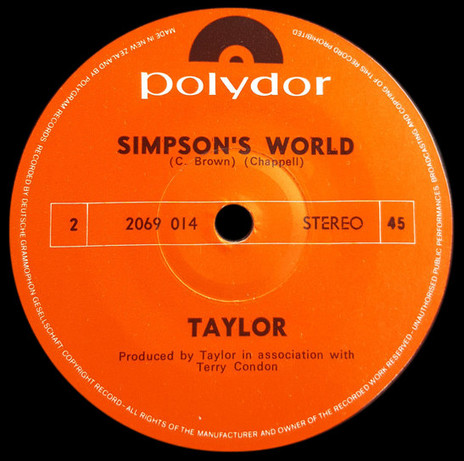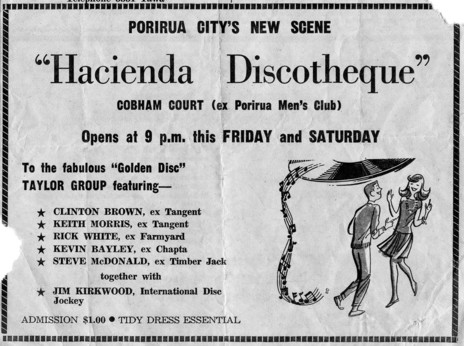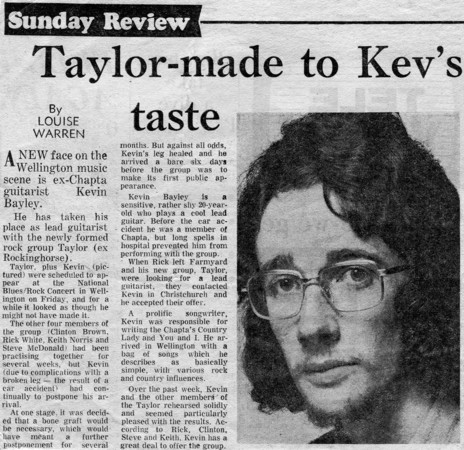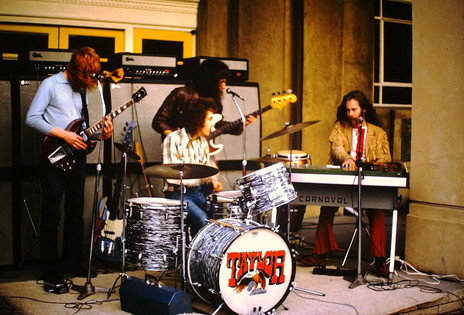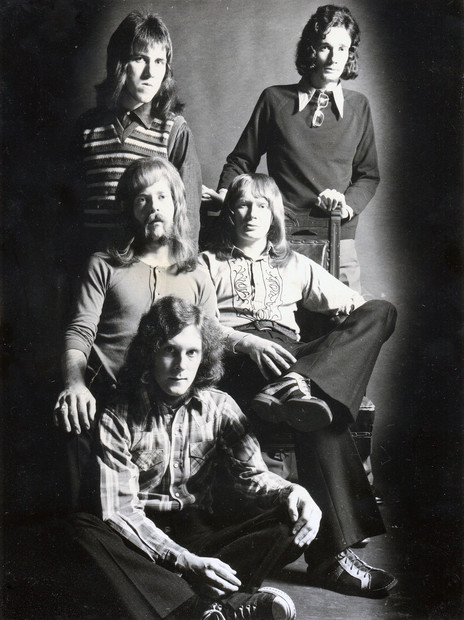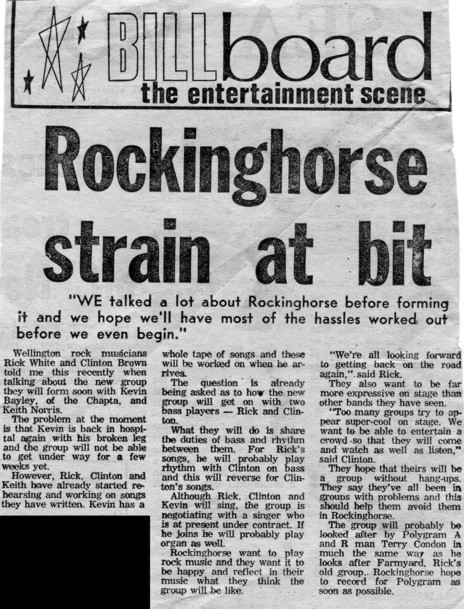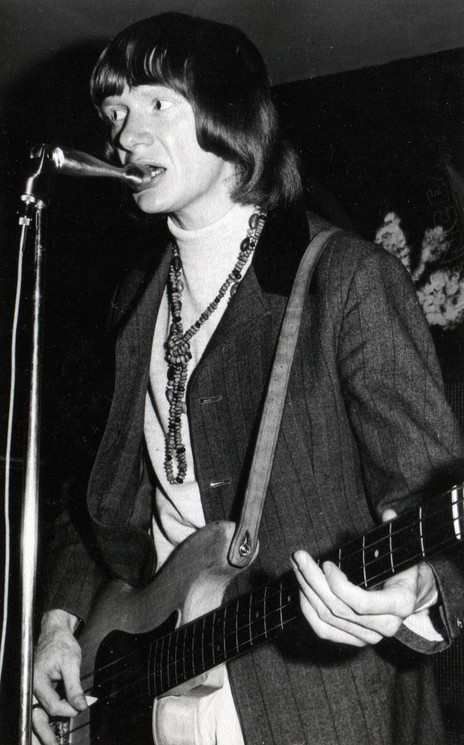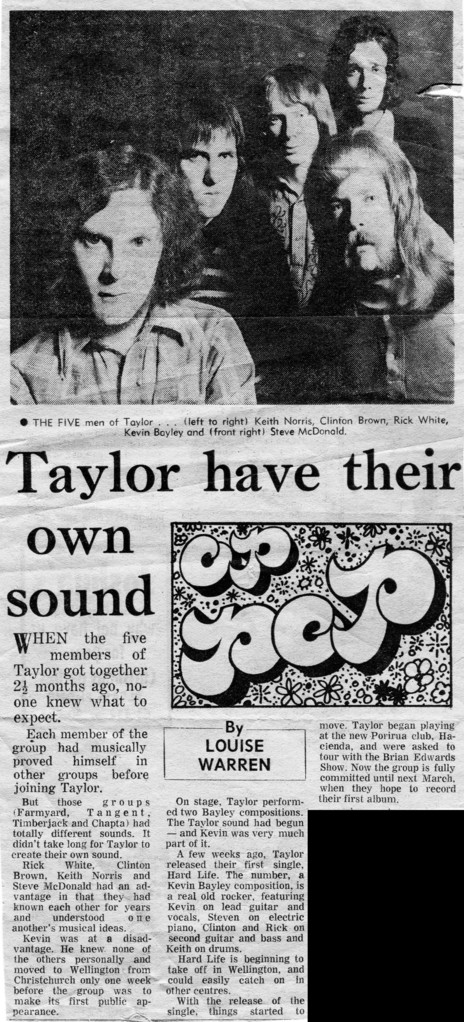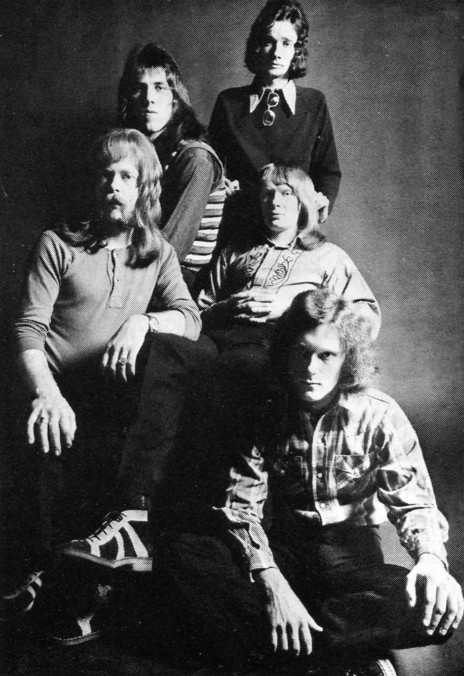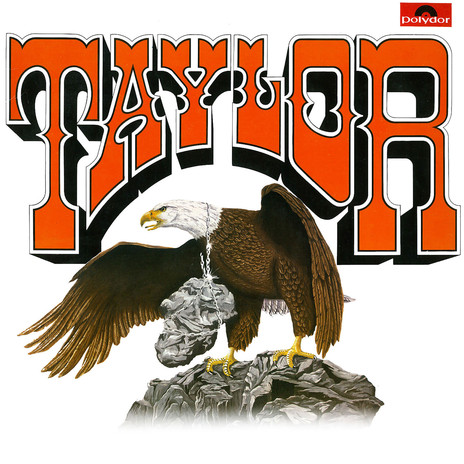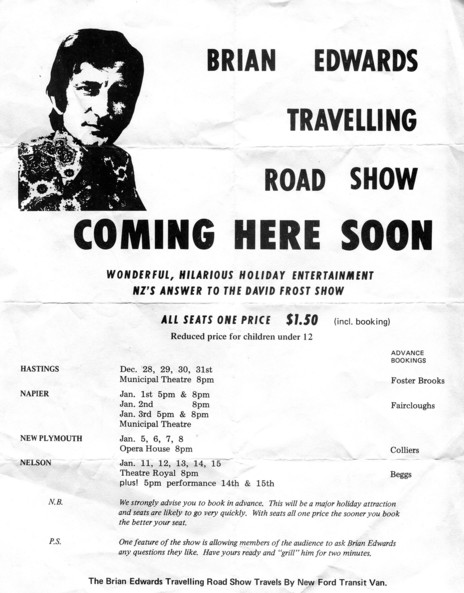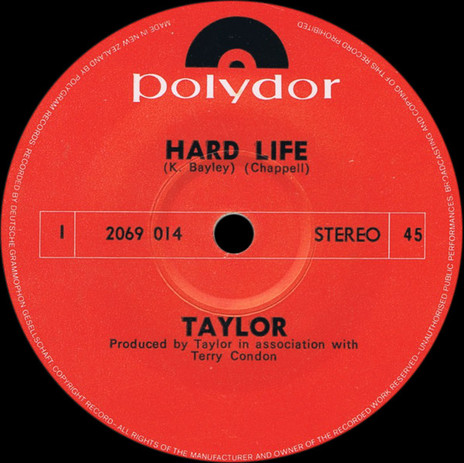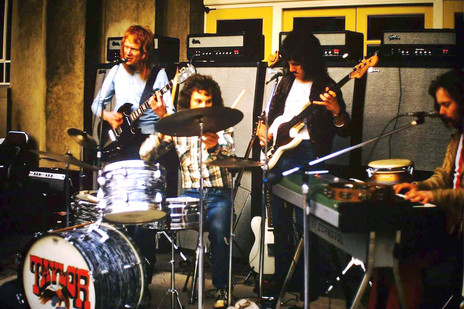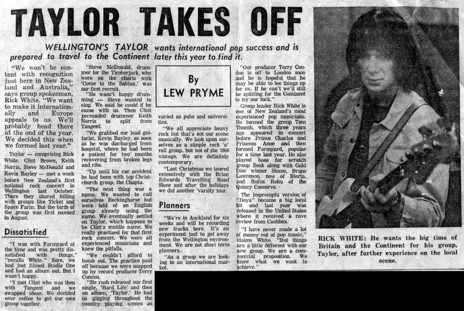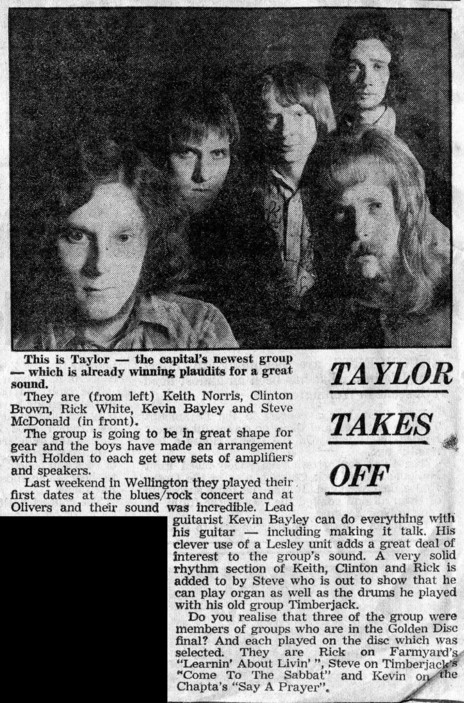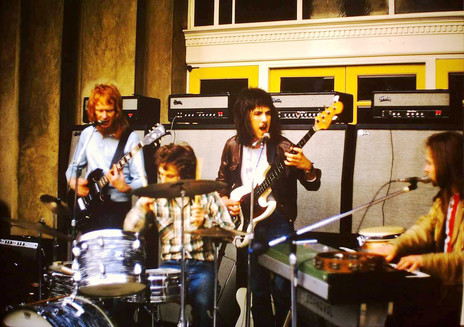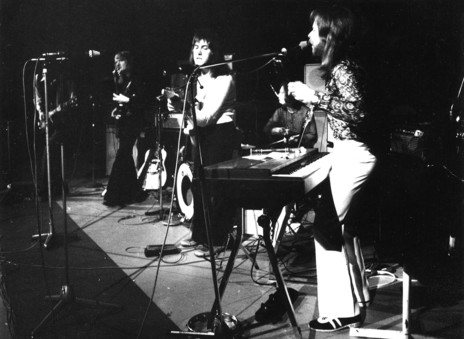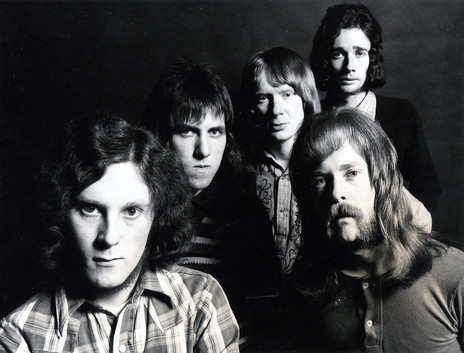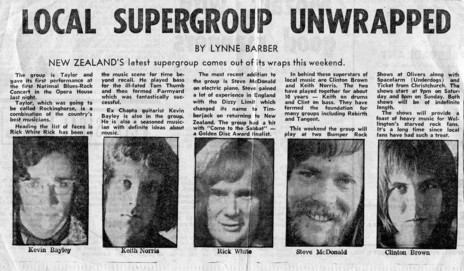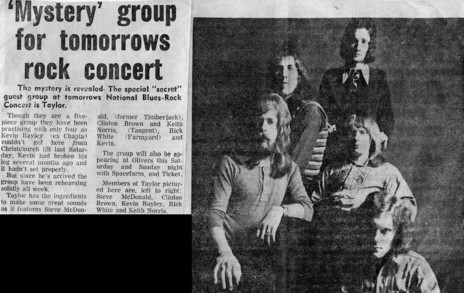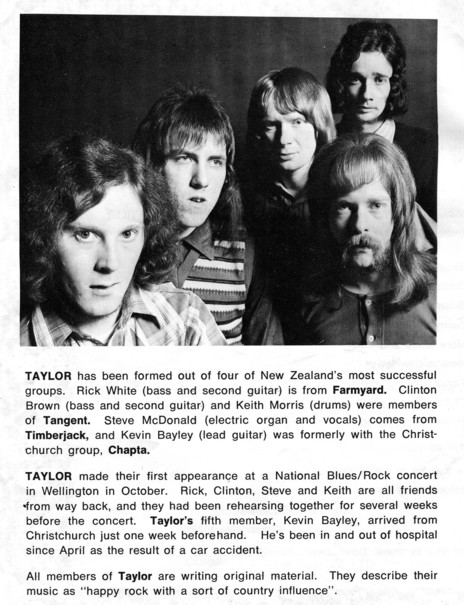Taylor had already been gigging a few weeks when three of them featured in former bands as finalists at the Loxene Golden Disc awards in November 1971. White was on the list with Farmyard for ‘Learning ’Bout Living’, Steve McDonald with Timberjack for ‘Come To The Sabbat’, and Kevin Bayley with The Chapta for ‘Say A Prayer’.
Taylor had emerged earlier in the year after Rick White had extracted himself from “the creative but quite stressful” Farmyard. White’s pedigree stretched back to the R&B of The Relics and Tom Thumb, but his time on stage and in the studio with Farmyard had him yearning for a less tense environment.
He found a kindred spirit in old mate Clinton Brown, the only issue was both were bass guitarists. That was easily solved when they agreed to divide bass and rhythm guitar duties as the material dictated. Brown had been White’s “first best man” as well opening for Tom Thumb at The Place while part of The Society.
Conveniently, Brown came with drummer Keith Norris, another founding member of The Society. In 1969, Brown and Norris formed Rebirth with guitarist Mike Farrell and in 1970 crossed the Tasman and hooked up with Milton Parker in Tangent. By March 1971, Brown and Norris were back in Wellington.
ex-Chapta guitarist Kevin Bayley Impressed Clinton Brown, and he was invited to join.
Discussions turned to a lead guitarist and Brown suggested The Chapta’s Kevin Bayley. When Tangent were down south, Bayley’s playing had blown Brown away and the two became friends. White put a call in to Christchurch and Bayley was on board. Coincidentally, White and Bayley had just seen each other’s bands on television earlier that evening.
As for a singer, the as-yet-unnamed quartet recruited singing drummer Steve McDonald, who had spent six months in London with Dizzy Limit before the band returned to New Zealand, renamed themselves Timberjack and released ‘Come To The Sabbat’. With the drummer’s stool occupied, McDonald reverted to the keyboards he had learnt as a boy.
While Bayley was still in Christchurch, the rest of the band practised and wrote in a rehearsal space off Manners Street, also working up cover tunes. They recorded their progress and sent the tapes to Bayley who taped his own ideas and sent them back. Bayley’s hitherto untapped ability as a singer was an added bonus.
Intending to name themselves Rockinghorse, the idea was thwarted when an HMV contact revealed there was already an English band of that name. Grasping at straws, they began suggesting their middle names. Rick White’s middle names of Athol Fern were not surprisingly passed over in favour of Clinton Brown’s moniker Taylor. Of course Brown, Norris and later Bayley would all feature in New Zealand’s own Rockinghorse later in the decade.
Taylor first appeared at a charity blues/rock concert at the Wellington Opera House in October 1971; Kevin Bayley more or less joining in straight off the boat from Christchurch. By summer they were on the road as part of the Brian Edwards Travelling Road Show, a variety revue written by Roger Hall and David Smith with additional material by, among others, broadcaster Paul Holmes. White recalls Edwards was supposedly giving up smoking and spent the trip cadging cigarettes.
The tour programme included an advert with Taylor and their new Holden amplifiers. Band manager Terry Condon initiated a deal with Christchurch musical equipment manufacturer Holden Sound that saw them receive four brand-new Holden stacks – two quad boxes each and four 200-watt amps!
“I got a call from Begg’s Wellington when the gear arrived in their store in Manners Street,” Clinton Brown recalled. “Went in and there they were! Very impressive sight.”
Soon, Taylor was the resident band at the new Lion Tavern in Wellington’s Molesworth Street as well as playing buck-a-head concerts and the Arts Council university circuit. On the strength of their individual recording history with Tom Thumb, Dizzy Limit, Rebirth, Farmyard and Timberjack, as well as the fact Condon worked at PolyGram, a record deal was a no-brainer.
Taylor started recording at Stebbing Studio in Herne Bay but scrapped it and reconvened at the more familiar HMV Studios in Wellington in late February 1972. Recorded over three days, engineered by the masterful Frank Douglas – and produced by the band under the “direction” of Condon – Taylor’s release was preceded by the single ‘Hard Life’, on Polydor, featuring the vocals of its writer Bayley.
Bayley penned four of the LP’s seven songs, Brown two and White the other. Brown and White shared bass guitar and second guitar while Bayley and Steve McDonald shared lead vocals. The material spanned the loping ‘Good Time Woman’ to the raunch of ‘Hard Life’ to the almost straight-ahead country of ‘Brand New Road’. Kevin Dunkley did the album’s distinctive artwork – an eagle with a rock chained around its neck – totally independently of the band. The album, released at the budget price of $3.50 in 1973 ($50 in 2021 money), is now highly sought after, with collectors paying several hundred dollars for a copy.
Later, Taylor made a deliberate effort to crack Auckland, securing a residency at John’s Place in Newmarket. All of them had tasted success in Wellington-based bands over the previous half a dozen years, but New Zealand’s biggest city posed a new challenge.
Despite attracting decent crowds, it became evident Taylor weren’t going to get much further. With White’s wife back in Wellington, he handed in his notice. An offer for White to play bass on tour with Tommy Adderley’s Headband fell over when their regular bassist Billy Kristian changed his mind and went anyway. Taylor continued for a short time as a four-piece before calling it quits in the middle of 1973 and returning to the capital.
in 2021, Rick White lamented Taylor was just “too much of a mates’ band.”
Looking back in 2021, Rick White lamented Taylor was just too much of a mates’ band and a bit lazy. “There was a fair bit of talent in the band but it was not put to a lot of use,” he said. “There was a lot of weed around in those days and if it got too difficult, roll another joint.”
Their talents have certainly been put to good use in the decades since. White went on to work in A&R and as a house producer at HMV/EMI, overseeing projects by BLERTA, Redeye, Ragnarok, Schtüng and even Fred Dagg. Clinton Brown and Keith Norris moved straight from Taylor to form Rockinghorse with Fourmyula pair Wayne Mason and Carl Evensen and Australian Pleazers guitarist Bruce “Phantom” Robinson. Brown later joined Sharon O’Neill’s band and has also been a member of The Warratahs and The Greg Johnson Set. Steve McDonald joined The Human Instinct long enough to record the legendary Peg Leg album before going on to a hugely successful solo career.
